Lockdown advocates will shamelessly claim (in the complete absence of evidence) that without their policies, the coronavirus pandemic would have been astronomically worse. Supposedly, lockdowns saved us (wrong), and any skepticism pointing out COVID-19's relatively low lethality can be immediately dismissed because we can blindly credit this to the lockdowns! Sweden throws a wrench into this nonsensical worldview.
As one of the few countries which refused to lock down or implement extreme mitigation strategies (like useless mask mandates), Sweden became the target of countless finger-wagging articles and modelers predicting doom.
Neil Fergusons Imperial College model was largely responsible for sending the world into a panic - predicting 2,000,000 deaths in the US and ~100,000 deaths in Sweden.
Likewise, the equally influential IHME didn't fare so well either.
Needless to say, the "experts" weren't even close. Anyone using "models" to justify their destructive policy prescriptions at this point deserve to be laughed out of the room.
Worse yet, when later predictions in the year don't pan out, they shamelessly move their disaster predictions further into the future, where they still fail to materialize.
Clearly, doomer predictions for Sweden have been flat out wrong all year. Had they been correct, we would expect Sweden's results to be dramatically worse than other European nations (not just worse within their own region - more on this below).
Some would attribute this success to population density (this is possible even when the graph is population adjusted). This claim doesn't pan out when we consider that the vast majority of Sweden's real cases occurred in it capital, Stockholm City, where the population density is the same as Chicago.
Now we can try putting COVID-19 into context. If Sars-CoV-2 were an unprecedented or unique virus requiring all sorts of (useless) government action, we would expect to see significantly higher death rates and excess deaths this year compared to previous years and flu seasons.
Here's how this years "deaths from all causes per 100,000" compare to the previous 5 years, let alone the previous five more deadly flu seasons.
Lets expand upon the previous graphs. How do this years "Deaths per Month per Million" compare to the previous 40 years?
Lets expand even further. Any ridiculous comparisons to the Spanish Flu must be dispelled immediately.
Same chart, more info:
I'm sure we're all capable of drawing rational conclusions from the above charts. Mainly, the coronavirus wasn't nearly as bad as "experts" thought it would be, and looks far less scary once put into context.
Furthermore, by any respectable metric, Sweden's "pandemic" ended long ago. (chart pre-dates the more recent smaller spike. The new spike even strengthens the argument that seasonality, NOT useless mitigation measures like lockdowns/masks, is a superior explanation for COVID-19's ups and downs.)
COVID-19 burned itself out without destructive lockdowns, mask mandates, or any other unprecedented "public health" measures.
The existence of Sweden's example should truly be a thorn in the side of any bureaucrat with a savior complex advocating restrictions.
Not even increases in mobility seem to predict daily death rates. Same graph, more info:
Despite Sweden's completely unexpected phenomenal performance, many critics are quick to point out Sweden's higher death rates than other countries in its region; mainly Finland, Denmark, and Norway. Naturally, such critics are absolutely sure of themselves that this worse performance is attributable to Sweden's lack of life-altering non-pharmaceutical interventions.
However, it would be lazy for us to simply accept this baseless assertion. After all, there are plenty of other possible explanations we should consider. Here is one paper that outlines 15 other possible explanations for Sweden's higher death rate.
Perhaps the most compelling explanation is the "dry-tinder" argument. Essentially, the dry-tinder argument states that Sweden's low death rates in previous flu seasons left lots of unhealthy people (older, infirm) alive, who would otherwise be dead if met with a normal flu season. When these large numbers of vulnerable people are suddenly met with the coronavirus pandemic, they succumb.
This graphic shows Sweden's lighter flu season in comparison to other Nordic nations:

















Great Information! Thank you for researching and sharing! Wish others would realize there are options.
ReplyDelete